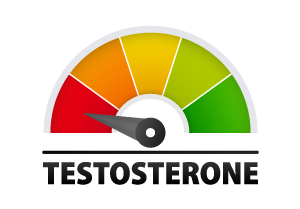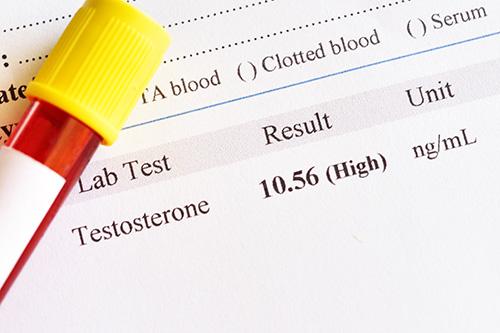What is testosterone? Understanding your testosterone levels.
Published
What you need to know about testosterone levels
- Testosterone is crucial in both males and females for muscle production, fertility, energy and sex-drive.
- High testosterone is common in women before the menopause and can cause acne, unwanted hair growth and a deeper voice.
- Low testosterone affects 1-in-4 men over 40 and causes low energy, difficulty putting on muscle, poor metabolic health and low libido.
- It’s simple to check your total or free testosterone with an at home finger-prick testosterone blood test.
Testosterone is the primary “male” sex hormone or “androgen” but it’s important in both males and females. It won’t surprise you to learn that testosterone levels in males are about 10x the levels in females. However, you might not know that females have much higher testosterone levels (5 to 10x) than their levels of either oestrogen or progesterone. So, regardless of your sex, you need to pay attention to your testosterone levels.
We’re going to cover why testosterone is important for both males and females, what low, normal and high testosterone levels are and what can cause them. But before we dive in, let’s go over the difference between total testosterone and free testosterone.
What’s the difference between free testosterone and total testosterone?
Free testosterone is generally considered the most accurate measure of someone’s “true” androgenic state.
You might have heard people talking about total testosterone and free testosterone. So what’s the difference?
Before we can answer this question you need to understand something about testosterone. Most of the testosterone in your blood is actually attached to two proteins - albumin and sex hormone binding globulin (SHBG). So testosterone exists in three forms in your blood: tightly bound to SHBG, weakly bound to albumin and not bound to anything or “free”.
The proportion of testosterone protein-binding is different between males and females:
| Males | Females | |
| Bound to SHBG | 30-45% | 70% |
| Bound to Albumin | 50-70% | 25% |
| Free | 3% | 1% |
Free testosterone is the amount of testosterone that’s not bound to any proteins and can easily exert effects on the body. Free testosterone is generally considered the most accurate measure of someone’s “true” androgenic state and studies have shown that low free testosterone levels correlate best with symptoms of testosterone deficiency1.
But even though free testosterone is probably the most useful biomarker, there’s a catch - it’s hard to actually measure it directly. There are various methods but they tend to be expensive and time-consuming.
Instead, most labs will calculate the free testosterone (instead of measuring it directly) from the levels of albumin, SHBG and total testosterone. The good news is that calculated free testosterone levels show very good correlation with measured free testosterone levels2.
What are bioavailable testosterone and the free androgen index (FAI)?
Two other testosterone related biomarkers you might come across are bioavailable testosterone and the free androgen index (FAI).
Because albumin binds relatively weakly to testosterone, there’s a school of thought that says that testosterone may be “bioavailable” when it’s free or when it’s bound to albumin. So “bioavailable testosterone” is the amount of testosterone that’s free or bound to albumin. Again, this is generally a calculation rather than an actual measurement and free testosterone is still considered to be the more useful marker.
Lastly, the free androgen index (FAI) is a ratio calculated by dividing the total testosterone by the SHBG level and multiplying by 100. The FAI is used as another way to assess someone’s androgen status. The FAI correlates pretty well with free testosterone levels in females but not in males3.This is because SHBG accounts for the largest proportion of protein-bound testosterone in females but not in males. FAI is mainly used to help diagnose women with polycystic ovarian syndrome.
What does testosterone do?
Testosterone plays an important role in the health and wellbeing of both males and females including:
- Muscle protein synthesis: testosterone is one of the major “anabolic” hormones meaning that it promotes muscle synthesis (growth)
- Bone density: testosterone is important for maintaining bone density
- Fat distribution: testosterone promotes a more metabolically healthy fat distribution with lower fat mass overall.
- Sex-drive: testosterone contributes to libido
- Energy: a low testosterone level can cause low energy
- Metabolic health: testosterone contributes to a healthy metabolism, including the regulation of lipids, cholesterol and glucose
- Red blood cell synthesis: testosterone stimulates the body to produce more red blood cells
- Fertility: testosterone promotes the development of sperm in males and follicles (eggs) in females.
What you need to know about testosterone levels
1-in-4 males over 40 have low testosterone levels.
Given that testosterone has so many effects in your body, it’s clear that knowing your testosterone level is important.
For males, the commonest issue is low testosterone. Testosterone levels fall in men after their 20s and up to 1-in-4 males over the age of 40 have low testosterone4. However, only 1-in-20 men over 40 will actually have symptoms related to low testosterone4 even though low testosterone could still be affecting their body composition and metabolic health.
For females, high testosterone may be an issue before the menopause while low levels are a more common problem after the menopause. Polycystic ovarian syndrome (PCOS) is a condition that affects pre-menopausal women and can cause symptoms such as irregular periods, acne, unwanted hair growth and weight gain. PCOS is associated with a high testosterone level and a high free androgen index.
Testosterone levels fall with age in females just as with males and low testosterone levels can be an issue for women after the menopause, causing low libido, tiredness, muscle loss and fat gain.
What are normal testosterone levels by age for males and females?
Normal total and free testosterone levels in males are shown in table 25.
| Age range | Normal total testosterone | Normal free testosterone |
| ≥ 18 | 225 - 830 pmol/L (65 - 240 pg/mL) | |
| 18 - 39 | 12 - 35 nmol/L (350 - 1000 ng/dL) | |
| 40 - 59 | 12 - 31 nmol/L (350 - 900 ng/dL) | |
| ≥ 60 | 12 - 25 nmol/l (350 - 720 ng/dL) |
Normal total and free testosterone levels in females are shown in table 35.
| Age range | Normal total testosterone | Normal free testosterone |
| Pre-menopausal | 0.3 - 1.8 nmol/L (10 - 54 ng/dL) | 2.8 - 32 pmol/L (0.8 - 9.2 pg/mL) |
| Post-menopausal | 0.24 - 1.39 nmol/L (7 - 40 ng/dL) | 2.1 - 23.2 pmol/L (0.6 - 6.7 pg/mL) |
Low testosterone levels
Symptoms and signs of low testosterone levels in males and females
- Low libido
- Low energy
- Low mood
- Erectile dysfunction in males
- Infertility in both males and females
- Difficulty putting on muscle
- Increased fat mass
- High cholesterol and blood sugar
Causes of low testosterone in males
Males produce the vast majority of their testosterone in the testes in response to a hormone called luteinising hormone (LH). LH is produced by the pituitary gland in the brain. So low testosterone levels in males can be due to a problem with testosterone production in the testes or, much more commonly, a problem with LH release from the pituitary gland.
Problems with testosterone production by the testes are typically caused by injury to the testes caused by trauma, drugs or infections.
Poor sleep and stress are common causes of low testosterone in males.
It’s much more common for low testosterone to be due to low production of LH from the pituitary which can be caused by or associated with:
- Poor sleep
- Stress
- Malnutrition
- Type 2 diabetes
- Obesity
- Taking steroids - e.g. anabolic steroids
- Overtraining
- Alcohol
- Age
- Pituitary tumours
Causes of low testosterone in females
In females, 25% of testosterone is produced in the ovaries, 25% in the adrenal glands and the remaining 50% is produced from the conversion of other steroid precursors to testosterone in tissues such as the skin, fat and liver.
As you can see, LH stimulation of the gonads (ovaries) in females plays a much smaller role in testosterone production than in males. Testosterone levels in females are therefore less sensitive to factors such as sleep and stress which decrease LH production.
The commonest causes of low testosterone in females are:
- Aging
- Menopause
- Contraceptives
- Taking steroids
- Problems with the adrenal glands
High testosterone levels
Symptoms and signs of high testosterone levels in males
- Acne
- Headaches
- High sex drive
- Infertility
- Difficulty sleeping
- High blood pressure
Causes of high testosterone in males
By far the commonest cause of high testosterone levels in males is taking testosterone replacement or using anabolic steroids.
More rarely, high testosterone levels in men can be caused by benign or cancerous tumours of the adrenal glands or testes that produce testosterone.
Symptoms and signs of high testosterone levels in females
- Unwanted hair growth on the face, chest and inner thighs (hirsutism)
- Acne
- Clitoral enlargement
- Deepening of the voice
- Breast shrinkage
- Lack of periods (amenorrhoea) and infertility
Causes of high testosterone in females
80-90% of women with high testosterone levels have polycystic ovarian syndrome.
About 80-90% of women with high testosterone levels have polycystic ovarian syndrome (PCOS)6. PCOS affects about 1-in-20 women before the menopause and moderately high testosterone levels are a common finding. The high testosterone is thought to be caused by excess production from the ovaries.
Other, relatively rare, causes of high testosterone in women include:
- Congenital adrenal hyperplasia: a genetic condition caused by mutations in genes responsible for producing cortisol in the adrenal glands. The block in cortisol production causes the adrenal glands to produce excessive testosterone.
- Anabolic steroids or testosterone replacement
- Tumours in the ovaries or adrenal glands
How to test testosterone levels
Fortunately it’s pretty straightforward to test your testosterone levels. You can check your total or free testosterone with a simple finger-prick blood test.
Want to check your testosterone levels? Order an at home test now.
Get tips on better health
Sign up to our emails on the better way to better health.
We'll keep you up-to-date with the latest research, expert articles and new ways to get more years of better health.







